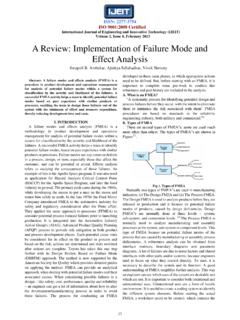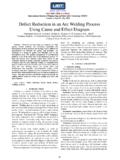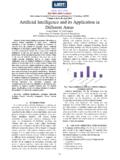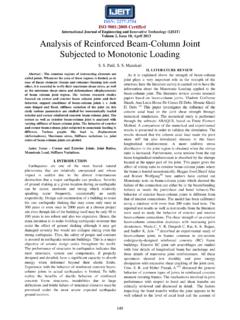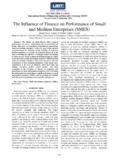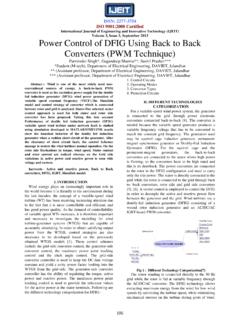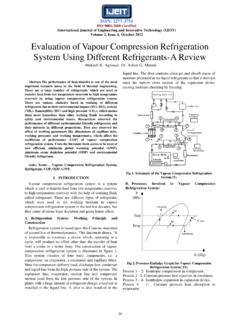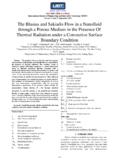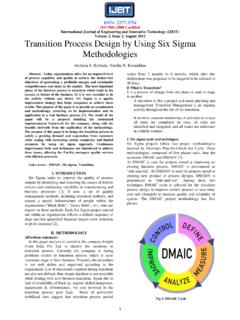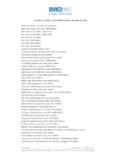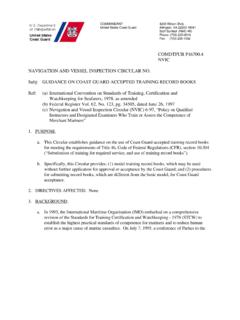Transcription of Rainfall Trends and Implications for Flooding in …
1 ISSN: 2277-3754 ISO 9001:2008 Certified International Journal of Engineering and Innovative Technology (IJEIT) Volume 2, Issue 10, April 2013 259 Rainfall Trends and Implications for Flooding in Northern Anambra State, Nigeria Ezenwaji,2V. 1 Department of Geography & Meteorology, NnamdiAzikiwe University, Awka 2 Department of Civil Engineering, Federal Polytechnic, Oko Abstract: The aim of this paper was to study the general direction in which the Rainfall of Northern Anambra State appears to be moving over 36 years (1975 2010), and determine its effects on the reoccurrence of annual Flooding in the area.
2 Rainfall data for the study were collected from both the Synoptic Meteorological Station at Amawbia and two Agro-Meteorological Stations in the area, while the number of occurrence of large flood events for 36 years was collected from both the Anambra State Ministry of Agriculture and the State Emergency Management Agency (SEMA). Data were analysed with the use of Trends Analytical Technique in which the bivariate regression was employed to produce the equation which summarises the linear relationship between Rainfall amounts (the dependent variable (Y)) and the year (the independent variable (X)).
3 With the equation we were able to determine the rate of Rainfall change. Furthermore, the technique was used to ascertain the contributions of Rainfall to Flooding in the area as well as achieved an ANOVA table used in determining the significance of the trend. Result shows that there is an increasing trend in Rainfall as could be seen in the regression equation Y = + , meaning that the area is getting wetter at the rate of With thisincrease, there is enough water for the ground water storage and river flow which will increase Flooding .
4 It was also found that Rainfall contributed to Flooding in the area. The p-value of led us to reject our null hypothesis that there is no significant relationship between Rainfall and annual Flooding . It was, however, suggested that early flood warnings, building of high foundation houses, onset and cessation of Rainfall periods in crop cultivation, integrated flood management etc. are necessary adaptation measures to be employed by the people to ameliorate the negative effects of Flooding in the area.
5 Keywords: Adaptation, Data, Direction, Emergency and flood. I. INTRODUCTION The heavy Rainfall amounts recorded in Nigeria between May and October 2012 have given rise to Flooding of unbelievable magnitude all over the country. Settlements along the courses of major rivers have been ravaged by rampaging floods. Anuforom (2012) opined that Rainfall amounts of the year all over the country were generally higher than long term mean values except in places in and around Kwara State.
6 This according to him has led to serious Flooding and opening of dams erected across rivers especially in rivers Niger and Benue. The Flooding events have led to the dislocation of families, destruction of farmlands and houses and loss of lives. However, over 90% of Nigeria is wetter than the normal conditions and this was the major reason for the unprecedented Flooding being observed almost everywhere. Quite expectedly very early in the year (2012) the Nigerian Meteorological Agency (NIMET) issued a warning that the year would be very wet which would result in serious Flooding in most parts of Nigeria especially between the months August and October 2012.
7 It further noted that the Flooding be generated by the Rainfall will be very serious in 12 States (NIMET, 2012). It was later seen that in the affected State, those worse hit were as expected, the riparian communities located in the flood plains of rivers Niger and Benue and their major tributaries. In Anambra State, Rainfall figures recorded so far in 2012 show a clear departure from the normal (Abbey and Nwankwo, 2012, Anambra State Ministry of Agriculture, 2012). Just recently, some communities in Anambra State including Umuodu, Ossomala, Ochuche, AkiliOgidi, AkiliOzizor and Atani in Ogbaru Local Government Area ( ) and Oroma-Etiti, Umuikwu, Umuem, Umudora, Nzam and other communities in Anambra West were overran by flood causing serious damage to lives and properties.
8 The same situation was found in Otuocha, Enugu Otu, EziaguluOtu and Nkpunando in Anambra East and Anaku in Ayamelum. These mishaps provoked the State Government to call on the Federal Government to declare the areas affected, disaster zones. Although we are aware that there are many causes of Flooding including socio-economic and anthropogenic activities (Ahman, 1997; Offiong and Eni 2008), topography and geological composition (Ministry of Environment Anambra State 2006 and Abbas, 2012), it is generally acceptable that Rainfall is the most common cause of Flooding worldwide (Nwagbara, Ijeoma and Chima 2010 and Agrawal 2010).
9 The paper therefore seeks to examine the Rainfall Trends and its implication for Flooding in the three Local government Areas of Anambra East, Anambra West and Ayamelum. Therefore, our hypothesis is formulated that there is no significant relationship between Rainfall and Flooding in the area. II. MATERIALS AND METHODS A. Area of the Study The three Local Government Areas that make up the Northern Anambra State are located between latitudes 6 .13`N and 6.
10 45`N , then longitudes 6 .43`E and 7 .13`E and cover 1,029sqkms which is about of 4,762sqkms, the total land area of the State (Fig. 1). The area is richly drained by the Anambra, Ezu and Ezechi rivers while the river Niger form its western border. ISSN: 2277-3754 ISO 9001:2008 Certified International Journal of Engineering and Innovative Technology (IJEIT) Volume 2, Issue 10, April 2013 260 The area has three geological formations namely; alluvium in the North West parts, Imo clay shale in the eastern parts, then the Bende-Ameki in the south (Orajiaka, 1975).
